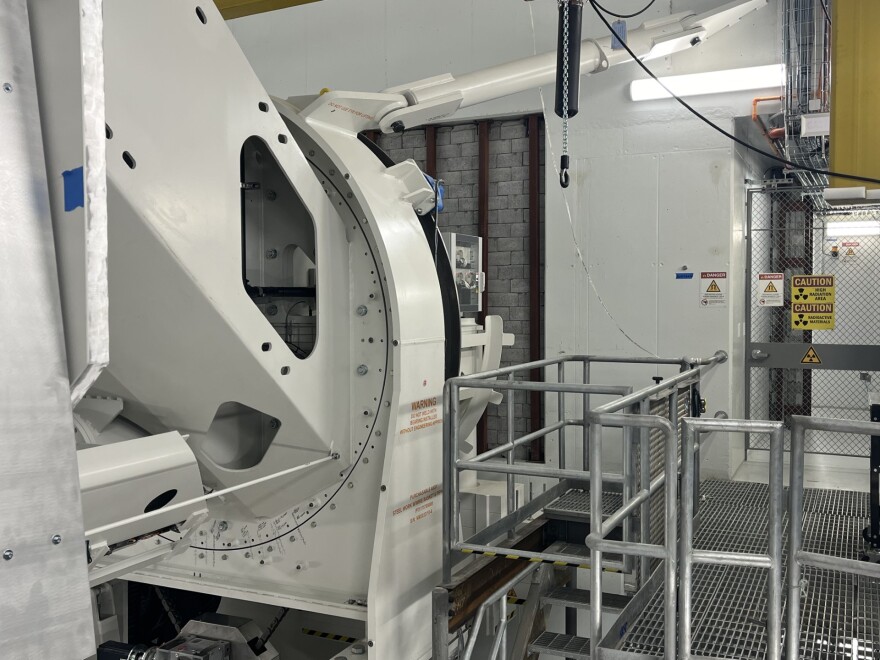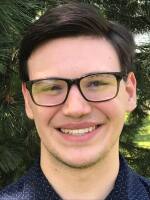OSF HealthCare is just a few weeks away from treating the first patients of the Peoria facility’s new Cancer Institute.
The boxy, modern building rises from the far end of the OSF HealthCare campus, attached to the second parking garage by a walkway. Construction crews are still hard at work installing desks, decorating the walls with various inspirational and religious quotes and sowing the soil outside to create the facility’s unique “healing garden.”
The $237 million, 200,000-square-foot construction project holds five floors of cancer care-related services, bringing together resources from disparate OSF locations around the Peoria community under one roof. Patients will find infusion facilities, dietary guidance, diagnostic testing, cancer support services, surgery and radiation therapy all on campus. OSF leadership estimates the building will serve 3,700 cancer patients each year.
It’s what CEO Bob Anderson calls a “holistic” approach to treatment. He said planning for the center started in 2014, with a groundbreaking in 2022.
“We've worked very hard to wrap ourselves around the patient and their cancer journey,” he said. “So that means we start with navigation and making sure patients know where they need to go and helping them with planning their appointments and their cancer journey.”

Tenille Oderwald is the manager of outpatient oncology services. She said the “navigation” piece of the center offers a wide array of services. “Nurse navigators” will work with patients from the time of their initial diagnosis.
“They really identify any barriers to patients,” Oderwald said. “When they’re diagnosed, there’s so many emotions, they’re overwhelmed. If we can provide that helping hand and really assist them, that’s really what our main goal is.”
That helping hand can take the form of counseling services, nutrition guidance, financial guidance for transportation, housing, utilities, insurance and more. Previously, Oderwald said navigation services were in a separate building from where patients were diagnosed. Now, everything is in close proximity.
“They no longer have to go from building to building and cross campus, driving out to see a provider in another facility,” Oderwald said. “They can come to this one building.”
Other services
Elsewhere in the building, there are 40 units for infusion treatment, both increasing the number of patients who can receive chemotherapy at once and bringing the service in from a separate Knoxville Avenue facility.

One floor above the infusion centers and cancer support services is a space for Illinois CancerCare and OSF Medical Group practices, including head, neck and gynecologic oncology surgery. Theoretically, a patient could receive a referral during an appointment on a lower floor and head just a few floors up to meet with a surgeon.
“We have multidisciplinary clinics where radiation oncologists, medical oncologists, surgical oncologists, as well as pathologists, radiologists will all look together at a case and come up with a treatment plan to discuss with the patient,” Anderson said. “Make those decisions and then get them in as quickly as possible for their treatment.”
In addition to infusion treatments like chemotherapy, the center will also be able to offer a treatment that’s not just rare for the region, or state, but the country. The basement of the facility is home to a proton beam, enabling the use of proton beam therapy.
Dr. James McGee, director of the oncology service line, said proton beam therapy allows for “pencil” radiation treatment.
"[Protons] enter the body, give up a little bit of energy, and then go a certain distance based on their energy,” McGee said. “And then they just stop and give up all their energy, where they stop, that’s called the Bragg peak. And that's a characteristic we can use to increase the intensity of radiation to certain tumors, but in virtually all cases, restrict the dose of radiation to normal tissues.”
McGee said this therapy is particularly effective for treating children with cancer, or the approximately 10% of cancer patients who can’t receive other forms of radiation therapy for one reason or another. This also is useful when tumors are near vital organs.
But proton beam therapy is far from widely available. When operational, the proton beam at OSF will be one of only three in the region. The other two are in the suburbs of Chicago and St. Louis.
“Sometimes, children go down to Memphis for proton therapy,” said Tom Cox, vice president of oncology services. “We wanted to offer those types of things here, so that people in our communities that we serve don't have to get on an airplane to find the best treatments, the best clinical trials.”
Reaching rural residents
As McGee points out, access to this sort of care is particularly challenging for rural residents. The full course of proton beam therapy can span as many as 25 to 30 sessions and many families can’t uproot their lives to travel across the country for five weeks.
Now, patients can receive this treatment right in their own backyard. The basement facility houses the machine patients lie on, as an entire half of the room rotates and dispenses the radiation. The room is outfitted with cameras and microphones so the patient can communicate with doctors outside the irradiated area. Just behind the facade of the machine, the massive proton beam apparatus sits in a room of concrete.

"There's a type of radiation called flash radiation where radiation treatment is given much more rapidly in terms of the dose rate in order to further reduce side effects on normal tissue,” McGee said. “And that's going to be an area that we'll be able to explore because we've designed all this to be capable of doing flash radiation. That's a project that we'll be doing research on for a few years.”
OSF officials say an entire space on the fourth floor, as much as 31,000 square feet of the facility, is dedicated entirely to research. Those facilities will be further developed after the treatment spaces are operational, but they’ll be a draw for researchers nationwide.
Anderson said travel by researchers and patients should have a measurable impact on Peoria.
“We'll have patients traveling here that will be here for weeks with their family,” he said. “So they'll be using our restaurants or hotels, our retail shops. That all has an additive impact to the Peoria economy.”

Elsewhere in the basement is a glass-walled room full of cooking spaces for one of the last services the building offers: dietary guidance and nutrition. The CEFCU Test Kitchen will provide classes for patients and caregivers alike to learn about serving the dietary needs of a cancer patient. They will also have access to herbs and produce from the “healing garden” just outside, to bring straight into the kitchen.
“As you go through treatment, we use the food that you eat to help keep your strength and energy up to help you manage symptoms, and then also to heal and recover,” said Katrina Sommer, an advanced clinical dietician. “So then once treatment is done, you can use your diet and the food that you eat to keep yourself healthy moving forward.”
Sommer said the kitchen provides an opportunity to focus on incorporating more plants into patients’ meals. Nutrients like fiber, she said, are critical for cancer treatment and recovery.
Patients will be able to access all of these services in a few days. Anderson the first patient for infusion and diagnostics is scheduled for Feb. 22, with proton and radiation therapy and the physicians' offices scheduled to open in March.
You can see the facility for yourself: OSF is hosting an open house from 10 a.m. to 4 p.m. on Saturday, Feb. 17. Tours are 45 minutes.


